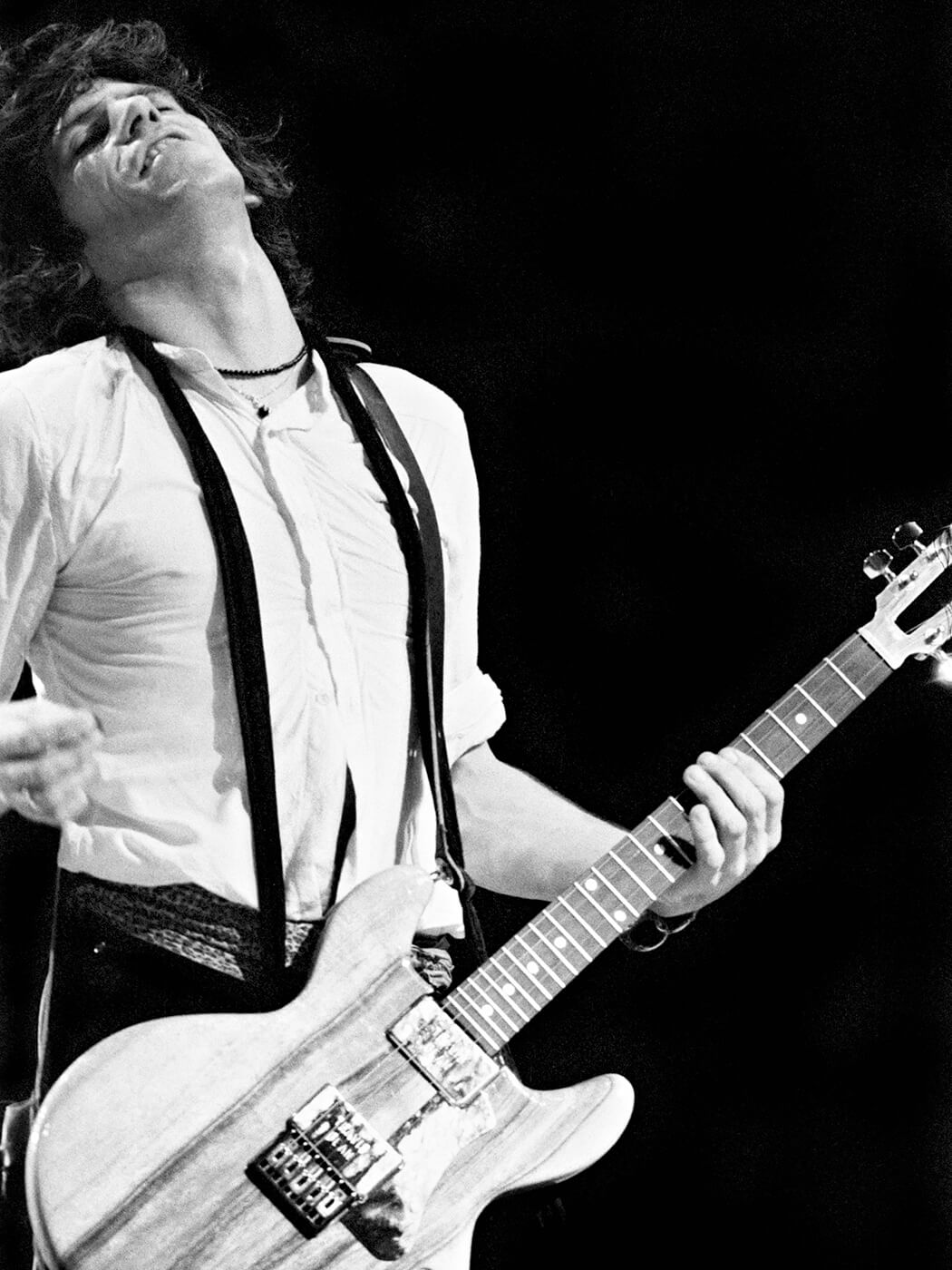Related Tags
A Brief History of Travis Bean Guitars
Famed for its aluminium necks and unique aesthetics, Travis Bean is one of the most individual makers in guitar history – a story of success borne out of ignorance of old guitar myths.

Yannis Philippakis with his Travis Bean guitar. Image: Gary Wolstenholme/Redferns/Getty Images
Travis Bean was a visionary luthier and machinist based out of California. In 1974 Bean, along with his business partners, Marc McElwee and Gary Kramer, started Travis Bean Guitars. They began building guitars with aluminium necks with a construction design that landed somewhere between a set-neck and a neck-through design. The aluminium necks extended down into the back of the body all the way down to the bridge and was inlaid into a wooden guitar body. This is sometimes called a “Pan-Back” design. The entire rear pan [headstock, neck and the rear half of the body] is machined from a solid billet of 7075-T651 aluminium. The necks often had a much more traditional rosewood fretboard glued to the aluminium pan.
The aluminium pan made these guitars incredibly sturdy – perfect for taking on the road. There was no need for a truss rod. They also added an extra layer of resonant properties to the guitar that made them quite unique.
Travis Bean was not the first to incorporate aluminium into a guitar neck, in fact, the first electric guitar, best known as the “Frying Pan” lap steel, constructed in the early 30s featured an aluminium neck. Later on, John Veleno began building all-aluminium guitars, complete with an aluminium fretboard with regular fret wire glued into the fret slots. Veleno built his first aluminium instrument in 1966-67 and went on to do a production run of about 195-200 of them between 1970 and 1977. So by the time Travis Bean started building his in 1974, it was already a niche concept that was being explored.

In a 1979 interview with Guitar Player magazine, Bean explained what led him to the idea of building necks out of aluminium, “It was based on my non-experience with guitars and my ignorance of old wives’ tales that would have made me believe a metal neck had to be wrong. Quite simply, I figured the aluminium neck would solve the problems that I’d been seeing Marc [McElwee] having to repair all the time.”
Travis had previously worked at a guitar store where Marc McElwee was the repairman. Bean and McElwee had a shared interest in music and designed the first iterations of what would become Travis Bean Guitar together. In 1974, when they felt they had a product worth selling, Travis Bean had been working at a car dealership in Reseda and had saved enough money to take the plunge and start Travis Bean Guitars with Marc McElwee. Gary Kramer, who had given Travis his job at the car dealership, would also join the team, but as a marketing guy.
When Gary Kramer did an interview with Kramer Korner in 2019, he recalled that one day Bean came to work at the dealership with an aluminum-neck guitar, which Gary described thusly, “[it looked] like a Smith & Wesson chrome barrel with a nice wood handle—that’s what I thought, because I wasn’t into guitars at all.” He joined the team, in his own words, “to make sure we got the sales going.”

Kramer’s eye for business would help him to start Kramer Guitars just a couple years later. The three set up shop in Sun Valley, California. Kramer marketed the guitar at NAMM and guitar stores across the country. The initial demand for the guitars was much more than any of the men ever expected and they struggled to keep up with production. According to Kramer, the business deal was soured when Travis Bean applied for the patent in his own name rather than the name of the company. Business relationships was strained further when, according to Kramer, Travis Bean started to become more interested in pursuing his new passion – drumming. Again, according to Kramer, Bean had converted a large section of the production floor space into a garage style-recording studio, complete with hundreds of egg cartons on the wall during a weekend when he was supposed to be filling orders to meet the incredible demand for his instrument. Ultimately this would result in Kramer severing ties with Travis Bean and starting his own company, Kramer Guitars. Travis Bean Guitars continued production of their guitar line until 1979. All together, they produced 3600 guitars and basses with a breakdown as follows:
TB500 (Budget Model) featured a Strat-type flat-top body with single coil pickups [usually two or three] with plastic covers. The bodies of these guitars were often made of magnolia, koa, or poplar. These were famously used by Steve Albini and Jerry Garcia [although Garcia also had a TB1000A as well]. 351 were produced.
TB1000S (Standard) was the first production guitar to come out of the factory. They had different stages of production throughout the life of the company. These came equipped with humbucking pickups with Alnico magnets – the stainless-steel casings for the pickups had “Travis Bean” stamped into them. They had a flat top construction typically made of koa or magnolia. These were the most common model and were played by Ace Frehley, Rick Nielsen, and even Slash. 1422 were produced.
TB1000A (Artist) featured the same humbucking pickups as the TB1000S, but with a carved top, and block inlays in the neck. Keith Richards received a custom-built 5 string version of this model. 755 were produced. TB2000 (Standard Bass) were typically made with Koa wood bodies and sometimes were custom built as short-scale or fretless. Bill Wyman received a custom made short-scale version of this model. 1020 were produced.
https://www.gettyimages.com/detail/news-photo/charlie-watts-and-bill-wyman-performing-with-the-rolling-news-photo/98344831?adppopup=true
TB3000 (Wedge) was Bean’s answer to the Gibson Flying V. Keith Levene of Public Image Ltd. used this model, as did Steve Albini. Only 45 were produced.
TB4000 (Wedge Bass) was a bass version of the Flying V – 36 were produced. Vincent Gallo is rumored to have played a one-off TB500 bass as well.

The bodies were always made of wood – typically Koa or magnolia [a rare wood in guitar construction], although some earlier guitars off the line were made of teak and padauk. The guitars all featured a 24.75″ scale and fixed bridges. The headstock shape has a cutout in the middle in the shape of a “T”. They most commonly sported black or natural finishes but were also offered in rarer colours like white.
The use of aluminium was not without its criticisms, these guitars were a bit heavier than their all-wood counterparts, and some criticised the feeling of aluminium necks being unnatural. Travis clapped back against this criticism in a 1979 interview with Guitar Player, pointing out, “Unless you’ve got a totally worn-out Telecaster, you’ve never felt wood in your life—you’ve been feeling the finish.” – a fair point.
The use of aluminium in guitars, particularly the necks, is still something employed today by some boutique guitar builders although original Travis Bean Guitars are highly sought after in the vintage market. Travis Bean passed away in 2011 but his legend and his visionary spirit live on.
